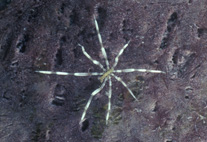Abstract
Antonbruunia sociabilis sp. nov., an abundant endosymbiont of Thyasira scotiae from a putative sulphidic ‘seep’ in the Hatton-Rockall Basin (1187–1200 m), North-East Atlantic Ocean, is described. The new species is compared with A. viridis and A. gerdesi from the West Indian Ocean and South-East Pacific Ocean respectively. The three species can be distinguished using a suite of morphological characters, and are associated with geographically separated chemosynthetic bivalve molluscs from different families (Thyasiridae, Lucinidae, Vesicomyidae) living in sediments at different depths. New morphological features are recognized for Antonbruunia and a re-assessment of its systematic affinities indicates a close relationship with the Pilargidae. Previous suggestions of an affiliation with the Nautiliniellidae, recently incorporated into the Calamyzinae (Chrysopetalidae), were not supported. The apparent morphological similarities between the two groups are indicative of convergence related to their shared relationships with chemosynthetic bivalves. The first molecular analyses of Antonbruunia (16S and 18S rDNA) clearly indicate that a close relationship to Pilargidae (represented by Ancistrosyllis sp. and Sigambra sp.) is more likely than an affinity to Calamyzinae (represented by Calamyzas amphictenicola, Natushima sp., and Vigtorniella sp.).

